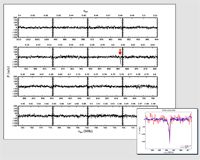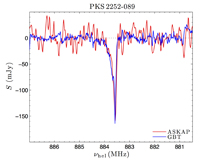BETA commissioning probes hydrogen across the distant universe
|
The BETA spectrum, showing the whole |
|
A 'close-up' of the BETA spectrum, showing the |
11 July 2014
As part of ongoing commissioning tests with the 6-antenna ASKAP commissioning array known as ‘BETA’, a new spectrum has been produced that demonstrates the wide bandwidth of ASKAP and the ability of the telescope to probe a large range of redshift space.
BETA, the Boolardy Engineering Test Array, represents the first six ASKAP antennas installed with phased array feed (PAF) receivers, along with the associated digital systems, hardware correlator and beamformer. BETA is primarily an engineering test array used to prepare for the full fit-out of the 36 antenna ASKAP telescope, but already has been producing interesting early science results for the team.
Commissioning activities over recent months have produced the first spectral line data cube, a stunning wide-field image of the sky, as well as encouraging results from an initial exploration of ASKAP imaging capabilities.
In a project to detect HI and OH absorption towards distant radio galaxies, observation of the 1Jy radio source PKS 2252-089 with BETA has produced a spectrum across the whole 300MHz instantaneous bandwidth of ASKAP.
In this band the HI 21 cm line covers a redshift range of 0.4–1.0, corresponding to a look-back time of 4.3–7.7 billion years. The absorption line which arises in the z=0.6064 host galaxy of the radio source was originally detected using the Green Bank Telescope (Curran et al., 2011), providing a useful comparison to cross-check the BETA data.
According to CSIRO Bolton Fellow Dr James Allison, the spectrum shows that ASKAP will be a powerful tool that will allow astronomers to explore a previously unexplored redshift space.
“Importantly, this project demonstrates we can use ASKAP – even in its early stages as the BETA commissioning instrument – to systematically explore the neutral hydrogen content of galaxies in a new epoch of the Universe. This cool neutral gas traces the reservoirs of fuel in galaxies for forming stars and feeding the central supermassive black hole,” says James.
The target was chosen as part of ongoing preparations for one of the ASKAP Survey Science Projects, FLASH – the First Large Absorption Survey in HI, which aims to detect and measure several hundred HI absorption lines to provide a unique dataset for studies of galaxy evolution as well as a new estimate of the HI mass density at intermediate redshifts.
The commissioning test is just one in a number of activities being undertaken by the ASKAP Commissioning and Early Science team to investigate the capabilities of the BETA system; other work includes calibration, continuum imaging, and beamforming with the PAF and the associated digital systems. The PAFs being used on BETA are the 'first generation', or Mk I, design.
Concurrently, the ASKAP team is also preparing the next generation Mk II PAF for deployment to the MRO, where on-the-ground testing of the ADE system will take place before installation on an ASKAP antenna.
Back to Latest ASKAP News page.


